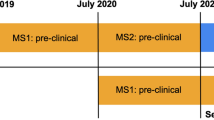Abstract
Background
Laparoscopic surgery is associated with a shallow learning curve. AnubiFiX embalming technique enables laparoscopic surgical training on supple embalmed and hence insufflatable human specimens in the dissection room. Aim of the present trial is to test whether dissection-based anatomy education is superior to classical frontal classroom education on the short and long term.
Methods
A total of 112 medical students were randomized in three groups. Group I attended classroom education, group II laparoscopic dissection-based education and group III received both. All groups completed an anatomy test on human specimens before, immediately after and 3 weeks after the anatomy training.
Results
Group II and III scored significantly better compared to group I immediately after the anatomy training (p I–II < 0.001, p I–III < 0.001). This difference was still significant after 3 weeks (p I–II < 0.001, p I–III < 0.001). No significant difference was found between group II and group III immediately after the course (p = 0.86), nor at the follow-up (p = 0.054).
Conclusions
The AnubiFiX™ embalming technique enables laparoscopic anatomy education in human specimens, with superior outcomes on the short and long term, as compared to classical frontal classroom education.



Similar content being viewed by others
References
Miskovic D, Wyles SM, Ni M, Darzi AW, Hanna GB (2010) Systematic review on mentoring and simulation in laparoscopic colorectal surgery. Ann Surg 252:943–951
Neumayer L, Giobbie-Hurder A, Jonasson O, Fitzgibbons R Jr, Dunlop D, Gibbs J, Reda D, Henderson W (2004) Open mesh versus laparoscopic mesh repair of inguinal hernia. N Engl J Med 350:1819–1827
Schouten N, Simmermacher RK, van Dalen T, Smakman N, Clevers GJ, Davids PH, Verleisdonk EJ, Burgmans JP (2013) Is there an end of the “learning curve” of endoscopic totally extraperitoneal (TEP) hernia repair? Surg Endosc 27:789–794
Wake BL, McCormack K, Fraser C, Vale L, Perez J, Grant AM (2005) Transabdominal pre-peritoneal (TAPP) vs totally extraperitoneal TEP laparoscopic techniques for inguinal hernia repair. Cochrane Database Syst Rev 25:CD004703
Eklund AS, Montgomery AK, Rasmussen IC, Sandbue RP, Bergkvist LA, Rudberg CR (2009) Low recurrence rate after laparoscopic (TEP) and open (Lichtenstein) inguinal hernia repair: a randomized, multicenter trial with 5-year follow-up. Ann Surg 249:33–38
Eker HH, Langeveld HR, Klitsie PJ, van’t Riet M, Stassen LP, Weidema WF, Steyerberg EW, Lange JF, Bonjer HJ, Jeekel J (2012) Randomized clinical trial of total extraperitoneal inguinal hernioplasty vs Lichtenstein repair: a long-term follow-up study. Arch Surg 147:256–260
Nienhuijs S, Staal E, Strobbe L, Rosman C, Groenewoud H, Bleichrodt R (2007) Chronic pain after mesh repair of inguinal hernia: a systematic review. Am J Surg 194:394–400
Lau H, Patil NG, Yuen WK, Lee F (2003) Prevalence and severity of chronic groin pain after endoscopic totally extraperitoneal inguinal hernioplasty. Surg Endosc 17:1620–1623
Slieker JC, Theeuwes HP, van Rooijen GL, Lange JF, Kleinrensink GJ (2012) Training in laparoscopic colorectal surgery: a new educational model using specially embalmed human anatomical specimen. Surg Endosc 26:2189–2194
Ten Brinke B, Klitsie PJ, Timman R, Busschbach JJ, Lange JF, Kleinrensink GJ (2014) Anatomy education and classroom versus laparoscopic dissection-based training: a randomized study at one medical school. Acad Med 89:806–810
Lange JF, Kleinrensink GJ (2002) Surgical anatomy of the abdomen. Elsevier, Maarssen
Singer JD, Willett JB (2003) Applied longitudinal data analysis—modeling change and event occurrence. Oxford University Press, New York
Cohen J (1992) A power primer. Psychol Bull 112:155–159
Shuell TJ (1988) The role of the student in learning from instruction. Contemp Educ Psychol 13:277–278
Author information
Authors and Affiliations
Corresponding author
Ethics declarations
Disclosures
Pieter J. Klitsie, Bart ten Brinke, Reinier Timman, Jan J. V. Busschbach, Hilco P. Theeuwes, Johan F. Lange and Gert-Jan Kleinrensink have no conflicts of interest or financial ties to disclose.
Rights and permissions
About this article
Cite this article
Klitsie, P.J., ten Brinke, B., Timman, R. et al. Training for endoscopic surgical procedures should be performed in the dissection room: a randomized study. Surg Endosc 31, 1754–1759 (2017). https://doi.org/10.1007/s00464-016-5168-3
Received:
Accepted:
Published:
Issue Date:
DOI: https://doi.org/10.1007/s00464-016-5168-3




